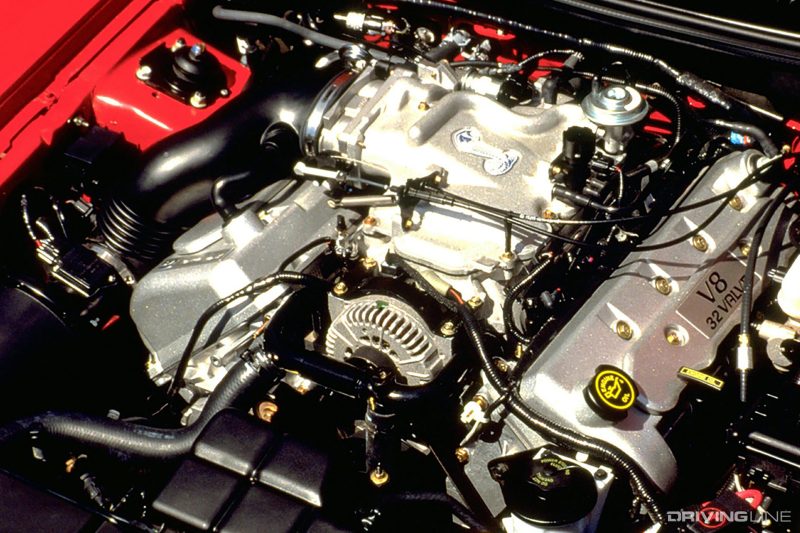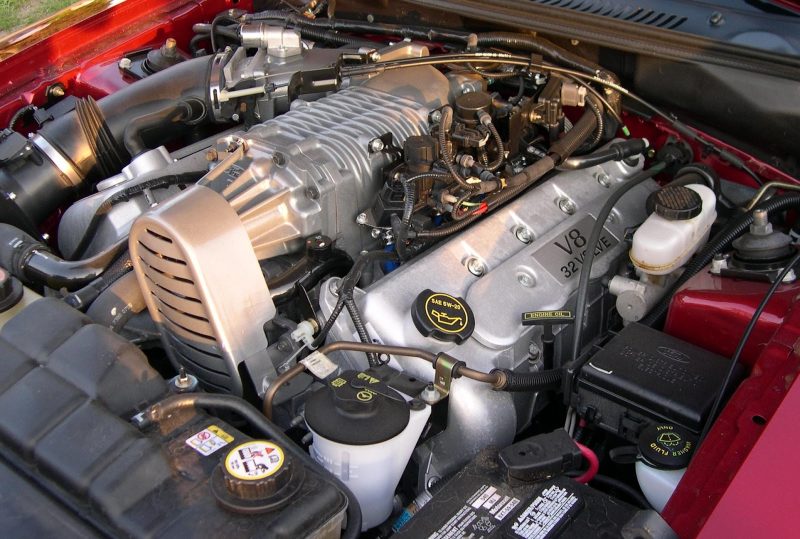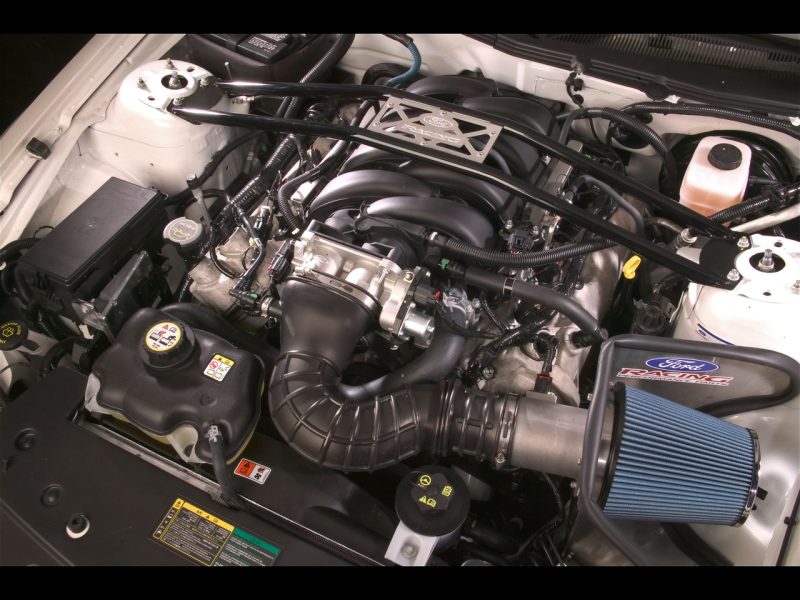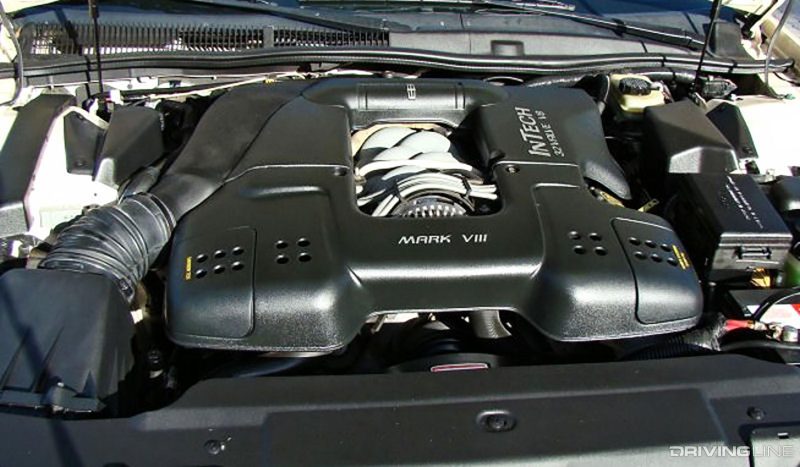The first Ford 4.6L V8 engine was introduced in 1991 and went into the 1991 Lincoln Town Car. It was the first Modular overhead camshaft engine designed by Ford. Besides powering the 91 Lincoln Town Car it was also seen in a lot of other Ford vehicles like sports cars, Pickup, Cargo vans and a lot more. What is the other most interesting thing is that this was Ford’s first engine architecture that became a small part of Ford’s big modular family. After its introduction, the engine was used in the V8 Mustang GT.
The first iteration of this engine used a 2-valve SOHC or Single Overhead Cam, a configuration that allowed this engine to draw, for that time frame, a magnificent 190HP and 260 lb-ft of torque. This is all naturally aspirated of course. The dual overhead cams and turbos and superchargers came somewhat later and they allowed this engine to offer you a staggering 800+HP with 600+lb-ft of torque. Around this time Ford started producing a four-valve DOHC model for use in the SVT Cobra and Mach 1. The 32-valve DOHC engine, called the 4.6L V8 Four-Cam, made its debut in 1993 in the Lincoln Mark VIII.
Ford 4.6 – 2, 3, and 4-valve V8 Engines:

The Ford 4.6 engine is a versatile model because it can be used with 2-valve, 3-valve, and 4-valve configurations.
The 2-valve (which was used primarily from 1990 through 2014) was used in a wide variety of vehicles including Lincoln Town Cars, Crown Victoria’s, Mercury Grand Marquis, and others. Another thing that these 2-valve engines brag about is the fact that they are bulletproof, especially the ones without cam phasers, and without VVT or variable valve timings. Just straight and solid cam gears make this type of engine pretty fun and even the non-Ford guys have to give props for this engine.
The 3-valve engine was used from 2005 through 2010 and it was originally featured in 2005 Ford Mustangs. Lide the 2-valve it had a single overhead camshaft. The 3-valve option has an apex-shaped combustion chamber as well as central-positioned spark plugs, along with two intake valves and a large exhaust chamber, which helps with velocity. This engine, in this configuration, and straight from the 2005 Ford Mustang made it to the Wards as one of the top 10 Best Engines.
The 4-valve, 4.6 Ford engine was first introduced in 1993 and it was found in the Lincoln Mark VIII. This engine type included cylinder heads with two intake ports per cylinder (split-port) and variable runner length intake manifolds with either vacuum or electrically actuated intake manifold runner controls (IMRC) depending on use from 1993 to 1998. Updated cylinder heads with tumble-style intake ports (one intake port feeding two intake valves), new camshaft profiles, and fixed runner-length intake manifolds were added to the engine for 1999. When compared to older 4-valve engines, these upgrades resulted in a higher power, torque, and a wider power band -like these https://reman-engine.com/remanufactured-engines/ford.
The Valvetrain on all of the models had low-friction rocker arms, and all models have aluminium or cast-iron blocks, depending on the year they were made.
Accolades:
The famous 4.6L V8 from Ford has a lot of stories to tell and it has made plenty of people happy. There are more accolades this engine received than criticism overall. There is no such thing as perfection, but for most this engine was close to it in its time.
The 4.6 litres, 4-valve V8 received numerous accolades for several years in a row. In 1996 and 1997, the engine received positive notice from numerous sources and was listed as one of Ward’s 10 Best Engines. The 3-valve engine also made the list from 2005 through 2008. The final 4.6 L engine was produced in May 2014. The engine was a 2-valve version and installed in a 2014 model year Ford E-Series van.
No Engine is Perfect:

As we already stated there is no such thing as perfection. If it was you would see another iteration of this engine running today, but the things are like they are. Even this 4.6L V8 came with some of its issues and they are presented right here.
While this engine has been used for years in many high-end vehicles, there have been some issues through the years. Here are some of the most common engine issues to be aware of:
- Intake Manifold Issues: The 4.6 engines often have defective intake manifolds, which is one of the most important parts of the engine as it regulates the airflow going between the engine cylinders. Some of the issues reported include prematurely cracked and corroded manifolds, which restricted air flows, caused oil to leak, created vacuum and coolant leaks, and caused intake tuning valves to become inoperable. The problem appears to be caused by the plastic it is made of. The problem was most often seen in the model year 2001 and earlier. Unfortunately, a cracked manifold cannot be repaired, it needs to be replaced. A cracked manifold can cause:
- Overheating
- Coolant leaking
- Vacuum leaking
- Oil Pressure Issues: Oil pressure issues are very serious, all engines need oil to operate, when there are issues, several things can inhibit the engine from working properly. Here are some of the ways that vehicle owners are made aware of an oil pressure problem:
- Low-pressure light will ignite on the dashboard
- The engine can overheat from low oil pressure
- Knocking sounds can occur inside the engine; this requires immediate attention to reduce the possibility of serious engine issues
- Timing Chain Issues: In most cases, the timing chain guides and tensioners are the cause of the issues. It is most often seen in engines that have been used in vehicles for several years, and in most cases, the timing chain will be replaced along with the guides and tensioner.

Overall, the 4.6L V8 engine was not bad in either of its valve iterations. It offered a lot of fun and a lot of adjustability and interchangeability. It was ready for upgrades and more power straight off the line, and it could take a lot of beating. If you invested a bit and upgraded some parts you could end up with a beast of an engine that is close to 950 HP which is still insane given today’s standards. Issues were obvious and some of them were engine related while others were specific component related so you can either judge it by that or not at all.
Overall, this was an icon of the engine that brought glory for Ford guys and girls all over in that period.

